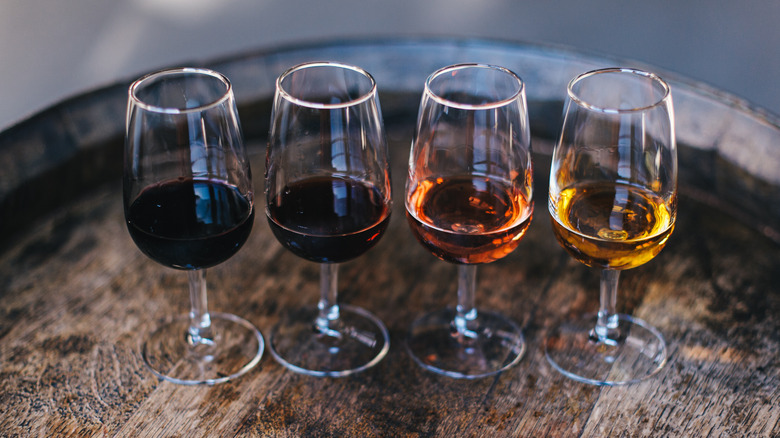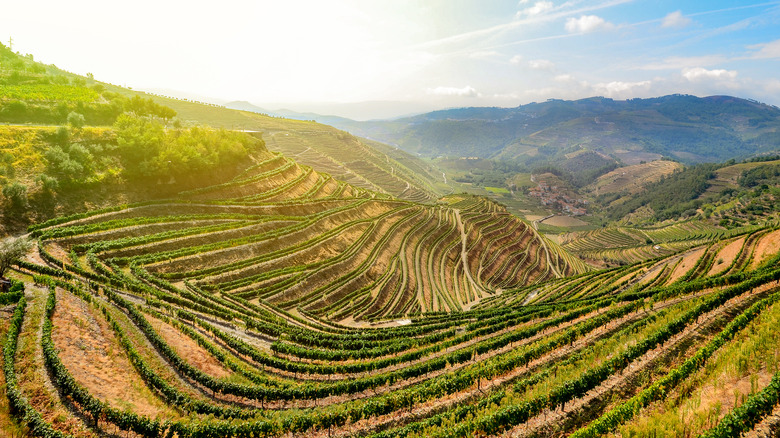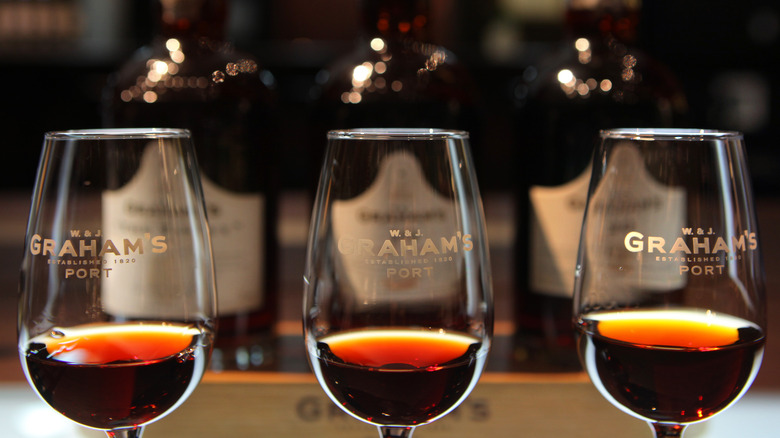Port Wine: Here's The 411
Port is a type of fortified wine with a long and prolific history that dates to the 17th century. The origin of port relates to the British and the Portuguese, who had pivotal roles in creating a wine so unique that it managed to stay relevant centuries after its invention and that is still considered by many to be one of the best dessert wines in the world.
There aren't many wines that can match port's richness and opulence. They are usually big, bold, and powerful, with a compelling blend of complex aromas and an incredibly smooth texture. Traditionally labeled as dessert wines, ports are generally sweet. The sweetness and incredible technical skill turn these full-bodied wines into palatable, easy-to-drink nectars. Forget the sickening sweet horror wines you might've had before; port is all about balance. Naturally preserved sweetness perfectly pairs with a silky mouthfeel and a slightly higher alcohol content. This is the wine you slowly sip after dinner or pair with blue cheese and decadent desserts.
Port is a style of wine, but it is also a protected wine appellation with a long list of sub-styles and categories. If you also add complex technical aspects of its production, the world of port can sometimes seem slightly overwhelming. This round-up can make things easier and guide you through this legendary style. It will help you choose your port of choice and inspire you to drink more of it.
Port wine is not produced in Porto
The name port wine is often misleading, as it suggests that this legendary wine comes from Porto, a picturesque Portuguese town nestled on the bank of the river Duoro in the vicinity of the Atlantic Ocean. Though Porto is intricately related to port, the entire port production happens upstream in an area officially named Duoro Valley. As explained by Wine Tourism, Douro is divided into three sub-regions, and though fortified port is the flagship style, the region also produces excellent, mainly red, dry wines. Porto is situated outside the Douro Valley, but it has always served as the financial and economic center where port wine was stored, aged, and shipped outside the country.
Douro Valley is a large wine-growing region with terraced vineyards dispersed on the slopes facing the Douro river. Apart from creating a spectacular landscape, the entire area is culturally significant and has been under UNESCO's protection since 2001. UNESCO recognizes Douro Valley as a place of exceptional interest due to its beauty, historic wine-making tradition, and significant technological progress.
Production is strictly regulated and controlled
Port is technically demanding to make. Apart from the traditional winemaking practices, it also includes fortification, extensive aging, and blending as additional steps that require skill, knowledge, and precision. As port is generally considered to be one of the finest wines in the world, port houses continually have to meet the required standards if they want to retain their hard-earned reputation, but they are not the only ones who oversee the quality of port wine.
When port wines became big-time players, there was a need for stricter regulations and a governing body that would regulate the entire port production. The change came in 1933 in the form of the Port and Douro Wines Institute (IVDP). The institute is a public organization that acts as a regulating body for all producers. The professionals from the institute oversee production. They regulate how much wines come from the region and if it fulfills the strict criteria.
IVDP not only controls the quality of the wines from the region, but it also acts as an international advocate for port and works hard to preserve the exclusive protection status and the well-earned international reputation of port wines.
Most port is made with five grape varieties
As it's a protected wine region, all aspects of port production are strictly regulated, including the choice of grape varieties. The Douro is a large region filled with many native varieties, and though more than 60 can be used to make port, only five local grapes are considered to have the best characteristics for production. Besides Tinta Barroca, Tinta Cão, and Tinta Roriz, perhaps better known as the Spanish flagship Tempranillo, Touriga Franca, and Touriga Nacional are generally considered the best varieties. Touriga Nacional is regarded as the finest and the most suitable for Port, but due to its finicky nature, Franca is the more commonly cultivated and used (via Vivino).
Thge Vintage Port Site explains that Touriga Nacional delivers those distinctive notes of dark berries we often find in port wines. It usually has a full body and good acidity, which is particularly useful for port during aging. The acidity keeps the wine fresh, and the harsh tannins have time to mellow down without disrupting the body. Touriga Franca, as the other prime grape, is perfect for the scorching conditions in the Douro. When it can fully ripen, it delivers bright acidity along with floral and fruity aromas.
Port is a fortified wine produced by adding grape spirit
Although people generally like to call it a dessert or a digestif wine, port officially falls in the category of fortified wines, meaning that neutral spirit is added to stop fermentation. It all starts with ripe grapes from Douro that are crushed and fermented. As the juice is extracted, it is fortified with wine brandy, which should be of the highest quality and is always at 77% ABV.
In the fortification process, the added spirit stops the yeast from consuming sugar and creating alcohol. The result is a sweet wine with a slightly higher alcohol content. Harvesting, pressing, and fortification are all important for port production, but the fascinating display of technical skill comes after when the port is aged and blended to create a perfectly balanced wine. The wine is first allowed to set in the Douro, but aging and blending all occur at Vila Nova de Gaia, a city just across Porto where all major port houses have their outposts. As Taylor's explains, in the cellar, before the wines are sent to Gaia, the winemakers decide what would be the most suitable style for each batch.
There are two main port styles
Style-wise, port is a vast category, but we can roughly talk about ruby and tawny as the two main style categories. For The Love Of Port explains that the technical process starts similarly, but ruby is primarily designed to be enjoyed young, fresh, and soon as it is bottled. It usually has no contact with oak and is left to develop for approximately two years.
Tawny port starts its life just like Ruby, but the difference comes with maturation. Tawny is aged in small oak casks, allowing contact with wood to aid oxidation. As the wine ages, that originally deep red color becomes a subtle brown hue. The wines also gain more complexity. The fruity flavors will still be present, but these wines will be dominated by tertiary notes often reminiscent of nuts, toffee, spices, dry fruit, and coffee. Unlike ruby, tawny port has exceptional longevity and can be aged for decades.
Because of differences in production and character, these wines are priced and served differently. Tawny is usually more expensive than ruby, and depending on the age, it can reach astronomical prices. While ruby makes an excellent option with chocolate or the classic port and stilton pairing, tawny is perfect for creamy desserts with a similar caramel-like and nutty profile.
Tawny port can have an age classification
Ruby port is a lovely, fruity, and approachable fortified wine, but tawny styles are generally considered superior and come close or can even match with some vintage ports. Due to its complex character and well-balanced profile, Decanter endearingly calls tawny the "queen" of port styles. What differentiates tawny from other styles is the aging process. When fortified wine is aged in small casks, which allows the wine to have more contact with wood, giving the blend of typical woody, spicy, and oxidative notes. Unlike vintage port, which comes from one specific year — which is stated on the bottle — tawny is a blend of different vintages and will always carry the time designation, depending on the age of the blend.
Decanter explains that the base label is Reserve, while other officially permitted classifications include 10, 20, 30, and over 40 Years. As an entry-level tawny, Reserve is refined and balanced, but as the age classification increases, the wines will typically show more elegance and become more polished. The biggest responsibility is with master blenders, who need to skillfully blend different wines to attain the perfect tawny expression that will align with the house's signature style.
Along with standard age classifications, tawny can also have Colheita label that includes single harvest tawny that is oak-aged for seven years minimum. Maturation can be extended, resulting in wines with different characters and flavor profiles.
Vintage port is the most prized variety
Vintage is often labeled as the finest port style. These wines are produced only in the best years and can only be made with exceptional grapes that usually come from the best plots. As explained by Decanter, the grapes are harvested at their peak, when they attain perfect ripeness. The vinification is equally important as the juice needs to be carefully extracted. This is traditionally done by stomping, but the use of mechanical "feet" is also common nowadays. The wine is then observed and tested to see whether it will fulfill the potential to be declared a vintage. Each port house decides whether the quality of the wine is considered worthy of the vintage label, but the final say is on the regulatory body that confirms or denies the declaration.
Vintage port is not filtered before being bottled, so it continues to develop inside the bottle, and the wines improve and become better with age. The longevity of vintage port is exceptional. As Decanter explained, the wines can be good young, but somewhere between 10 and 20 years, they enter the harsher "adolescent" phase and again tone down as they reach mature stages.
The first port houses were established by the British
If you ever look into the port selection of any reputable wine shop or decide to go to the source of port wines, you will notice that some of the biggest port houses have surprisingly British-sounding names. The reason you will see names such as Taylor's, Graham's, or Sandeman is quite interesting and goes way back to the 17th century when port began to take its shape in the Douro.
Splendid Table explains that the entire history and mainly promotion of port wine started with the British. Though the Douro produced wines well before the 17th century, what was coming from the region was astringent and harsh. The most famous story of its invention says that British merchants first discovered smooth and elegant wines at the local monastery, but the more reasonable explanation is that the brandy was first added to prevent spoilage during shipping to England. With time, the fortification was perfected, and it became the preferred technique in Douro as it resulted in subtly sweet and incredibly palatable wines.
Although German merchant Kopke established the first Port house in 1638, since 1670 and the establishment of Warre's estate, the trade was dominated by the British, and the houses still bear the names of their founders (via Vinho Do Porto).
Port-style wines are produced outside Portugal
Port wines have an excellent reputation, and as they are beloved worldwide, it's not surprising that other wine regions tried to copy the technique to get a similar style. Port is officially protected by the European Union, and it can be made only in the designated region of the Douro Valley, but the problems occur when you step outside the EU, where the same rules don't apply (via IVDP).
Jancis Robinson explains that most successful port-like wines outside Portugal come from Australia, South Africa, and California. Depending on the regional law, they can be labeled differently, but tawny and ruby labels might signal that the wine is trying to mimic the classic Portuguese style. If you can't get your hands on actual Portuguese port, look for other fortified or dessert wines rather than opting for lower-quality wines that deceivingly use the "port" label.
The biggest win for the port industry happened in 2010 with an official agreement, which also included several other European wine designations, between the EU and Australia that forbade the practice of using the port label. Since then, these port-style wines typically sell as ruby and tawny. Australian versions can be of very good quality and might be a great opportunity to try something similar yet different from the classic Douro-made port (via Decanter).
There is also white port
Although we mostly think of port as a powerful red wine, a small percentage of the production is designated for white blends, simply called white port. As you may assume, white port is more vibrant and refreshing compared to the classic red style. Instead of berries and spices, the flavor profile is reminiscent of stone fruit, citrus, and nuts (via Decanter).
According to Wine Enthusiast, white port is also produced by fortifying the base wine with a neutral spirit, but instead of red wine, the blends are made from local white varieties that are also cultivated in the Douro. The wines can be aged differently — it's either tank or barrel — and the maturation can be short or long. The length and the choice of the maturation technique will significantly influence the wine, resulting in examples of various complexity and different character, from approachable and easy-drinking white ports to big and bold wines that compare to the most fabulous red varities.
Decanter recommends it as a great summer option and suggests mixing it with tonic water to create the bitter-sweet Porto Tonico (Portónico), which is one of the favorite Portuguese traditions.
Port sales are expected to grow in the future
Although fortified wines have lost their primate in the wine industry and somehow don't fit in the recent trend of enjoying young, fresh, and approachable wines, they are still cherished and respected by the most knowledgeable connoisseurs. While many like to think of port as an old-fashioned, almost forgotten style, the numbers show a different story, and it seems that the consumption and the overall sales of port are expected to grow in the future.
The Drinks Business reported on research conducted by Grand View Research that forecasted market value and consumption trends of fortified wines from 2022 to 2028. The results showed that the market would grow by a predicted 10.9% CAGR within the projected period. The increase will likely happen because many think of fortified wines as a healthier option and due to the higher demand for celebratory drinks.
Research Dive states that the recent COVID-19 pandemic had a negative influence on the sale of port, but the market is expected to recover, and profit will most likely increase by 2028 due to more interest in premium beverages, general improvement in the appellation, and the introduction of new products and labels.
Port is a sweet wine that perfectly pairs with desserts and cheese
Port is a complex appellation filled with many sub-categories and styles that show different characteristics. Most examples will have some sweetness, which can range in intensity, suggesting that port should be treated as a dessert wine or after-dinner drink. Even the lightest styles are richly flavored, so serving them as a digestif is the best option. Because of this powerful character, port can sometimes be a challenging pairing partner, but it can work well with equally strong dishes, primarily flavorful cheese or heavy and fruity desserts.
Wine Folly recommends pairing ruby — the lightest and the freshest representative — with chocolate flavors and fruity desserts because they best match the fruit-forward profile of most ruby wines. A pungent European cheese would also be a good partner with ruby port. With more complex styles, look for more complex pairing options. Tawny port typically has more spices, black fruit, caramel, dry fruit, and nuts, and when it comes to pairings, it looks for similar flavors and aromas, so go for nut desserts, toffee-like flavors, and aromatic aged cheese. For vintage port, Wine Folly recommends the so-called "perfect pairing" of port and stilton, but you can easily go for any high-quality, blue-veined cheese and serve it alongside a vintage port.












